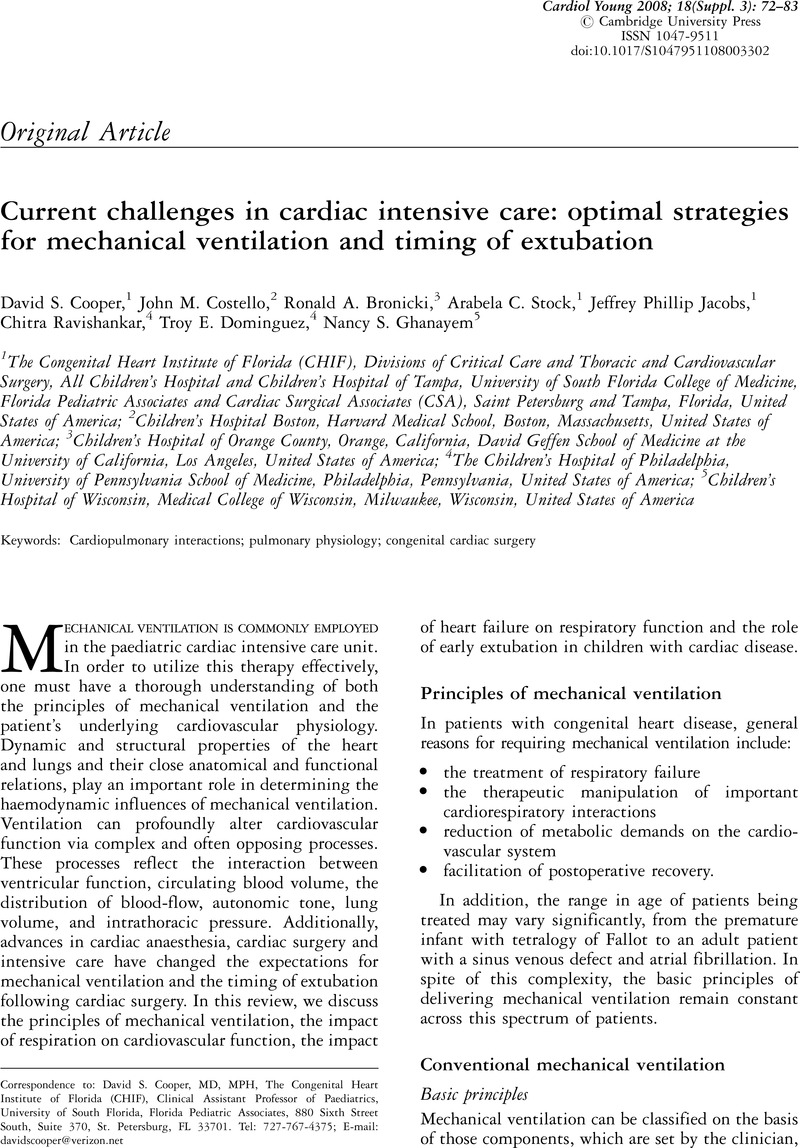Crossref Citations
This article has been cited by the following publications. This list is generated based on data provided by Crossref.
Kovacikova, Lubica
Skrak, Peter
Dobos, Dusan
and
Zahorec, Martin
2014.
Noninvasive Positive Pressure Ventilation in Critically Ill Children With Cardiac Disease.
Pediatric Cardiology,
Vol. 35,
Issue. 4,
p.
676.
Seguin, Jade
Albright, Benjamin
Vertullo, Laura
Lai, Pamela
Dancea, Adrian
Bernier, Pierre-Luc
Tchervenkov, Christo I.
Calaritis, Christos
Drullinsky, David
Gottesman, Ronald
and
Zappitelli, Michael
2014.
Extent, Risk Factors, and Outcome of Fluid Overload After Pediatric Heart Surgery*.
Critical Care Medicine,
Vol. 42,
Issue. 12,
p.
2591.
Iannucci, Glen J.
Oster, Matthew E.
Chanani, Nikhil K.
Gillespie, Scott E.
McCracken, Courtney E.
Kanter, Kirk R.
and
Mahle, William T.
2014.
The Relationship Between In-House Attending Coverage and Nighttime Extubation Following Congenital Heart Surgery*.
Pediatric Critical Care Medicine,
Vol. 15,
Issue. 3,
p.
258.
Lincoln, Patricia
Ahern, Jeanne
Braudis, Nancy
Brown, Loren D.
Bullock, Kevin
Evans, Janine
Guan, Yong Mein
Luo, Wenyi
Sheng, Nanping
and
Schroeder, Margaret
2014.
Pediatric and Congenital Cardiology, Cardiac Surgery and Intensive Care.
p.
1349.
Mahle, William T.
Jacobs, Jeffrey P.
Jacobs, Marshall L.
Kim, Sunghee
Kirshbom, Paul M.
Pasquali, Sara K.
Austin, Erle H.
Kanter, Kirk R.
Nicolson, Susan C.
and
Hill, Kevin D.
2016.
Early Extubation After Repair of Tetralogy of Fallot and the Fontan Procedure: An Analysis of The Society of Thoracic Surgeons Congenital Heart Surgery Database.
The Annals of Thoracic Surgery,
Vol. 102,
Issue. 3,
p.
850.
Rizza, Alessandra
Romagnoli, Stefano
and
Ricci, Zaccaria
2016.
Fluid Status Assessment and Management During the Perioperative Phase in Pediatric Cardiac Surgery Patients.
Journal of Cardiothoracic and Vascular Anesthesia,
Vol. 30,
Issue. 4,
p.
1085.
Rizza, Alessandra
and
Ricci, Zaccaria
2019.
Congenital Heart Disease.
p.
115.
Hamzah, Mohammed
Othman, Hasan F.
Baloglu, Orkun
and
Aly, Hany
2020.
Outcomes of hypoplastic left heart syndrome: analysis of National Inpatient Sample Database 1998–2004 versus 2005–2014.
European Journal of Pediatrics,
Vol. 179,
Issue. 2,
p.
309.
Hamzah, Mohammed
Othman, Hasan F.
Elsamny, Esraa
Agarwal, Hemant
and
Aly, Hany
2020.
Clinical Outcomes and Risk Factors for In-Hospital Mortality in Neonates with Hypoplastic Left Heart Syndrome.
Pediatric Cardiology,
Vol. 41,
Issue. 4,
p.
781.
Lincoln, Patricia
Braudis, Nancy
Brown, Loren D.
Bullock, Kevin
Evans, Janine
Guan, Yong Mein
Luo, Wenyi
Sheng, Nanping
and
Schroeder, Margaret
2020.
Pediatric and Congenital Cardiology, Cardiac Surgery and Intensive Care.
p.
1.
Wu, Keye
Chen, Fang
Wang, Yuanxiang
Ti, Yunxing
Liu, Huaipu
Wang, Pengcheng
and
Ding, Yiqun
2020.
The Experience of Early Extubation After Paediatric Congenital Heart Surgery in a Chinese Hospital.
Heart, Lung and Circulation,
Vol. 29,
Issue. 9,
p.
e238.
Checchia, Paul A.
Brown, Katherine L.
Wernovsky, Gil
Penny, Daniel J.
and
Bronicki, Ronald A.
2021.
The Evolution of Pediatric Cardiac Critical Care.
Critical Care Medicine,
Vol. 49,
Issue. 4,
p.
545.



